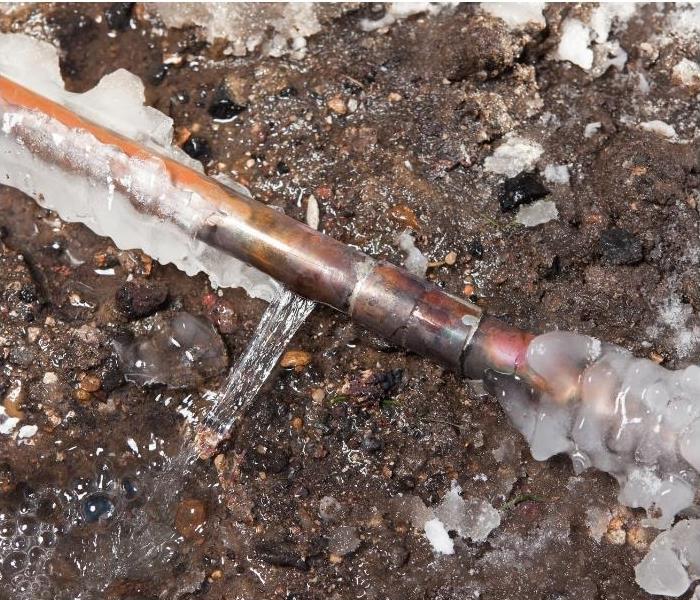How SERVPRO Can Help with Frozen Pipes and Water Damage
1/20/2025 (Permalink)
Winter brings many beautiful moments, from the coziness of holiday gatherings to the crisp air of snowy days. However, the colder months also bring a variety of home maintenance challenges, one of the most common being frozen pipes. When temperatures drop, pipes in uninsulated areas like basements, attics, and exterior walls are at risk of freezing. As the water inside them expands, it can cause pipes to burst, leading to serious water damage. Understanding how frozen pipes occur and the steps to take in case of a burst can help you protect your property from the costly consequences of water damage.
What Causes Pipes to Freeze?
Pipes freeze when the water inside them drops below freezing temperatures, causing the water to expand. This expansion puts pressure on the walls of the pipes, which can lead to cracks or even breaks. The most vulnerable pipes are typically those in areas without proper insulation, such as in garages, crawl spaces, or along exterior walls.
The risk of frozen pipes increases during extreme cold spells, especially when there is a prolonged period of subfreezing temperatures. Even homes that are well-insulated can be affected if there are drafts or areas where the insulation is compromised.
Once a pipe freezes, the water supply to that part of the house is interrupted, and when the ice melts, it can cause water to leak out, leading to serious flooding and water damage. Often, the real damage occurs after the pipe bursts, as water pours out and spreads quickly across the property.
Common Signs of Frozen Pipes
It’s crucial to spot the early signs of frozen pipes before they burst. Here are some common indicators:
- Reduced Water Flow: If the water pressure drops suddenly or water flow becomes weak, it may be due to frozen pipes.
- Frost on Pipes: If you notice frost or condensation on pipes, it could be a sign they are freezing.
- Strange Odors: In some cases, frozen pipes can lead to odors if they are located near drains or have been clogged.
- Unusual Sounds: If you hear banging or clanging sounds from your pipes, this could be the result of frozen water inside.
If you detect any of these signs, it’s important to act quickly before the situation worsens.
The Dangers of Burst Pipes
When a pipe bursts due to freezing, the situation becomes much more urgent. A burst pipe can release a large volume of water in a short amount of time, causing extensive water damage to flooring, drywall, insulation, and furniture. Water quickly spreads throughout a property, seeping into walls, ceilings, and flooring, leading to structural damage and, in some cases, the growth of mold.
Water damage from burst pipes can affect your home in several ways:
- Water Soaks Into Walls and Ceilings: Walls and ceilings can absorb water, which not only damages the material but can also create a breeding ground for mold and mildew.
- Flooded Basements and Crawlspaces: If a burst pipe occurs in a basement or crawlspace, water can quickly accumulate and cause significant damage to the foundation, insulation, and stored belongings.
- Damage to Electrical Systems: Water coming into contact with electrical systems can create a major safety hazard, potentially causing electrical shorts and fires.
- Mold Growth: Stagnant water from burst pipes provides an ideal environment for mold to grow. Mold can begin to spread within 24–48 hours, worsening the damage to your home.
How SERVPRO® Can Help with Frozen Pipes and Water Damage
SERVPRO of NE Salt Lake City is a trusted leader in water damage restoration, offering expert services to handle the aftermath of frozen pipes.
Here’s how SERVPRO can help:
1. 24/7 Emergency Response
Frozen pipes can cause immediate and severe damage, so quick action is essential. SERVPRO’s team is available 24/7 to respond to emergencies. Whether it’s late at night or during a holiday weekend, we are always ready to take action and prevent further damage. Our rapid response ensures that the water is contained and mitigation starts as soon as possible, helping to minimize the overall damage to your home.
2. Water Extraction and Cleanup
Once a pipe has burst, water can quickly spread across floors, walls, and ceilings. SERVPRO® has advanced water extraction equipment, such as industrial-grade pumps and vacuums, to remove standing water efficiently. Our team can also remove wet materials like carpeting, flooring, drywall, and insulation, which are often irreparable after being saturated with water.
3. Drying and Dehumidification
After the initial water extraction, it’s crucial to dry out the affected areas completely to prevent long-term issues like mold growth. SERVPRO uses high-powered air movers and dehumidifiers to dry both visible and hidden areas of your home. These specialized tools ensure that water trapped in walls, ceilings, and under flooring is removed, preventing further damage.
4. Mold Remediation
Mold is a serious concern after water damage from frozen pipes. If water damage is not dealt with quickly and properly, mold can begin to grow within 24–48 hours. SERVPRO offers mold remediation services to detect and remove mold from your property. Our technicians use advanced equipment to locate mold colonies, and we follow strict guidelines for safe removal to ensure the health and safety of your home and family.
5. Water Damage Restoration
After addressing the immediate water damage, SERVPRO can restore your property to its pre-damage condition. We handle everything from replacing flooring and drywall to repairing structural damage. Our goal is to make it “like it never even happened,” restoring your home to its original state.
6. Insurance Assistance
Dealing with the aftermath of water damage can be overwhelming, especially when it comes to working with insurance. SERVPRO of NE Salt Lake City can assist with the insurance claims process, working directly with your insurance company to ensure that the claim is handled smoothly and that you receive the proper coverage for the repairs and restoration.
Prevention Tips for Avoiding Frozen Pipes
While SERVPRO is here to help in the event of frozen pipes and water damage, prevention is always the best course of action. Here are some tips to help prevent frozen pipes:
- Insulate Vulnerable Pipes: Insulate pipes in attics, basements, and exterior walls. Foam pipe insulation or heat tape can prevent pipes from freezing.
- Keep the Heat On: Even if you’re away from home, leave the heat on to maintain a warm temperature, especially in colder areas of the home.
- Open Cabinet Doors: If temperatures are dropping, open the cabinet doors under sinks to allow warm air to circulate around the pipes.
- Let Faucets Drip: Letting faucets drip slightly can prevent pressure from building up in the pipes and help prevent freezing.
Frozen pipes and water damage are serious threats to your home during the winter months, but SERVPRO of NE Salt Lake City is here to help. With our 24/7 emergency response, water extraction, drying, mold remediation, and restoration services, we can restore your home quickly and efficiently. By acting fast and reaching out to SERVPRO, you can minimize the damage caused by frozen pipes and get your home back to normal in no time.
If you’ve experienced water damage from frozen pipes, contact SERVPRO of NE Salt Lake City today for immediate assistance and professional restoration services.





 24/7 Emergency Service
24/7 Emergency Service
